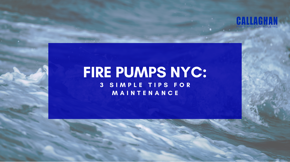When planning fire pump NYC, you should know how to maintain your fire pump. Here are some simple tips to get started with your fire pump maintenance journey.
Fire pumps NYC are systems that essentially provide the water pressure that a sprinkler system requires. They are utilized when the main water supply or municipal water system can’t provide the right amount of water pressure to meet the needs of a fire sprinkler system. These pumps are most often powered by diesel engines or electric motors.
They come in many different variations, including horizontal and vertical split-case, vertical inline, and vertical turbine pumps. No matter what type of fire pumps you need, it is important in all fire emergency situations.
As with all mechanical systems, a fire pump also requires regular inspection to ensure it stays in operating condition. Whether it’s the engine, motor, battery, fuel supply, temperature, alignment, or controllers, everything should be tested and maintained according to NFPA requirements. Here are some key tips for maintaining your fire pump:
First things first, your fire pump needs power. It is usually in the form of an electrical motor or a diesel engine. Make sure you check the power source at least once a year. In addition to performing a routine inspection, you should also cycle the source once or twice a year. Cycling will help you maintain lubrication and allow inspection of the running system. Also, this will help you ensure that there is fuel available for the power source.
In addition to the power source, you should also perform maintenance and inspections on the fire pump itself. Make sure everything is moving freely. This can be done using the appropriate lubricants on all moving parts. Take some time to move them around to keep them from locking in place. These parts should not seize or lock in place.
Once a month, test random sprinkler heads that trigger the fire jockey pump pressure. Before testing, you should notify the fire department. Let them know you are just testing your fire pump system and there is no fire emergency. Also, be sure to silence all alarms to avoid scaring your neighbours with the drill. While implementing these tests, you can perform a visual inspection to look out for any obvious repairs.
To make inquiries, reach out to us directly!
They come in many different variations, including horizontal and vertical split-case, vertical inline, and vertical turbine pumps. No matter what type of fire pumps you need, it is important in all fire emergency situations.
Maintenance, Testing, and Inspection of Fire Pumps NYC
Because of the vital role fire pump pressure relief valve settings have in fire protection, you should take testing and maintenance seriously. These pumps are not used very frequently, so it is crucial that you look into fire pump inspection. This is where you will need to keep the National Fire Protection Association (NFPA) in mind.As with all mechanical systems, a fire pump also requires regular inspection to ensure it stays in operating condition. Whether it’s the engine, motor, battery, fuel supply, temperature, alignment, or controllers, everything should be tested and maintained according to NFPA requirements. Here are some key tips for maintaining your fire pump:
- Check the Power Source
First things first, your fire pump needs power. It is usually in the form of an electrical motor or a diesel engine. Make sure you check the power source at least once a year. In addition to performing a routine inspection, you should also cycle the source once or twice a year. Cycling will help you maintain lubrication and allow inspection of the running system. Also, this will help you ensure that there is fuel available for the power source.- Move the Pump Parts
In addition to the power source, you should also perform maintenance and inspections on the fire pump itself. Make sure everything is moving freely. This can be done using the appropriate lubricants on all moving parts. Take some time to move them around to keep them from locking in place. These parts should not seize or lock in place.- Test Controls
Once a month, test random sprinkler heads that trigger the fire jockey pump pressure. Before testing, you should notify the fire department. Let them know you are just testing your fire pump system and there is no fire emergency. Also, be sure to silence all alarms to avoid scaring your neighbours with the drill. While implementing these tests, you can perform a visual inspection to look out for any obvious repairs.At Callaghan Pump…
We have an experienced team of fire pump professionals that can recommend the type of pump you need for your property. This will help you ensure that the fire pump you install will provide enough pressure for your entire sprinkler system to minimize the chances of fire damage. Some key types of fire pump pressure relief valve settings we offer include horizontal split case, vertical split case, vertical inline, vertical turbine, and end suction.To make inquiries, reach out to us directly!

No comments:
Post a Comment